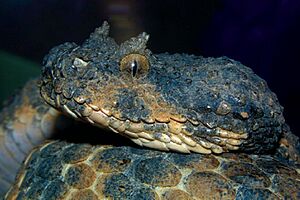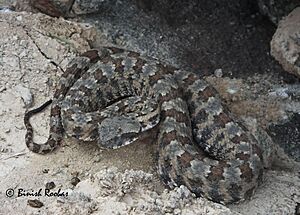Persian horned viper facts for kids
Quick facts for kids Persian horned viper |
|
|---|---|
 |
|
| Conservation status | |
| Scientific classification | |
| Genus: |
Pseudocerastes
|
| Species: |
persicus
|
| Synonyms | |
|
|
The Persian horned viper (Pseudocerastes persicus) is a type of venomous viper. It is found only in the Middle East and Asia. This snake gets its name from the horn-like scales above its eyes.
Contents
About the Persian Horned Viper
Adult Persian horned vipers are usually between 40 and 70 centimeters (about 16 to 28 inches) long. The longest one ever recorded was 108 centimeters (about 43 inches) long! Female snakes are typically bigger than males. These snakes can be quite heavy for their size, sometimes weighing over 500 grams (about 1.1 pounds).
What Does It Look Like?
The head of this snake is wide and flat. It's clearly separate from its neck. Small, overlapping scales cover its head. Its snout is short and round. The nostrils are on the top-sides of its head and have special flaps.
The most unique feature is the horn-like structure above each eye. These "horns" are made of small, overlapping scales. Even baby vipers have these horns!
The snake's body is covered in scales that can be slightly or very rough. Many of these scales have a ridge (called a keel) that ends in a bump or a point. In the middle of its body, there are 21 to 25 rows of scales. It has 134 to 163 belly scales and 35 to 50 pairs of scales under its short tail.
Names for This Snake
People call this snake by a few different names:
- Persian horned viper
- False horned viper
- Persian horned desert viper
- Eye-horned viper
Where Does Its Name Come From?
The name Persicus comes from Persia, which is now the country of Iran. This is where the snake is most often found. The "horned" part of its name refers to the horn-like scales above its eyes.
Where It Lives
The Persian horned viper can be found in several countries. These include Iran, Pakistan, Afghanistan, northern Oman, the United Arab Emirates, Jordan, and across a region called Mesopotamia.
Its Home (Habitat)
This snake likes to live in sandy areas, but not in big sand dunes. It also lives in rocky places with basalt and limestone rocks. These areas usually have some plants growing. The Persian horned viper tends to stay away from places where many people live.
How It Behaves
These snakes usually move quite slowly. They can move in different ways, like sidewinding (moving sideways), serpentine (wiggling), or rectilinear (moving straight forward). They live on land and are mostly active at night. You might see them during the day or early evening only when the weather is colder.
The Persian horned viper is not usually aggressive. However, if it feels threatened, it will hiss loudly. Unlike some other desert vipers, it cannot sink vertically into the sand to hide.
What It Eats
These vipers mainly eat lizards, small mammals like mice, and sometimes small birds. They also eat arthropods (like insects or spiders). They will even eat food that is already dead.
Reproduction and Life Cycle
The Persian horned viper lays eggs, which means it is oviparous. A female snake can lay between 11 and 21 eggs at a time. When the eggs are laid, the baby snakes inside them are already quite developed. Each baby snake can be as long as 8.5 centimeters (about 3.3 inches) inside the egg!
The eggs hatch after only about 30 to 32 days if kept at a temperature of 31 degrees Celsius (88 degrees Fahrenheit). When they hatch, the baby snakes are about 14.0 to 16.2 centimeters (about 5.5 to 6.4 inches) long. These snakes can be bred successfully in zoos or special breeding programs.
About Its Venom
Like all vipers, the Persian horned viper is venomous. Its venom can cause bleeding problems. There isn't a specific antivenom made just for bites from this snake. However, some general antivenoms for vipers might offer a little protection.



